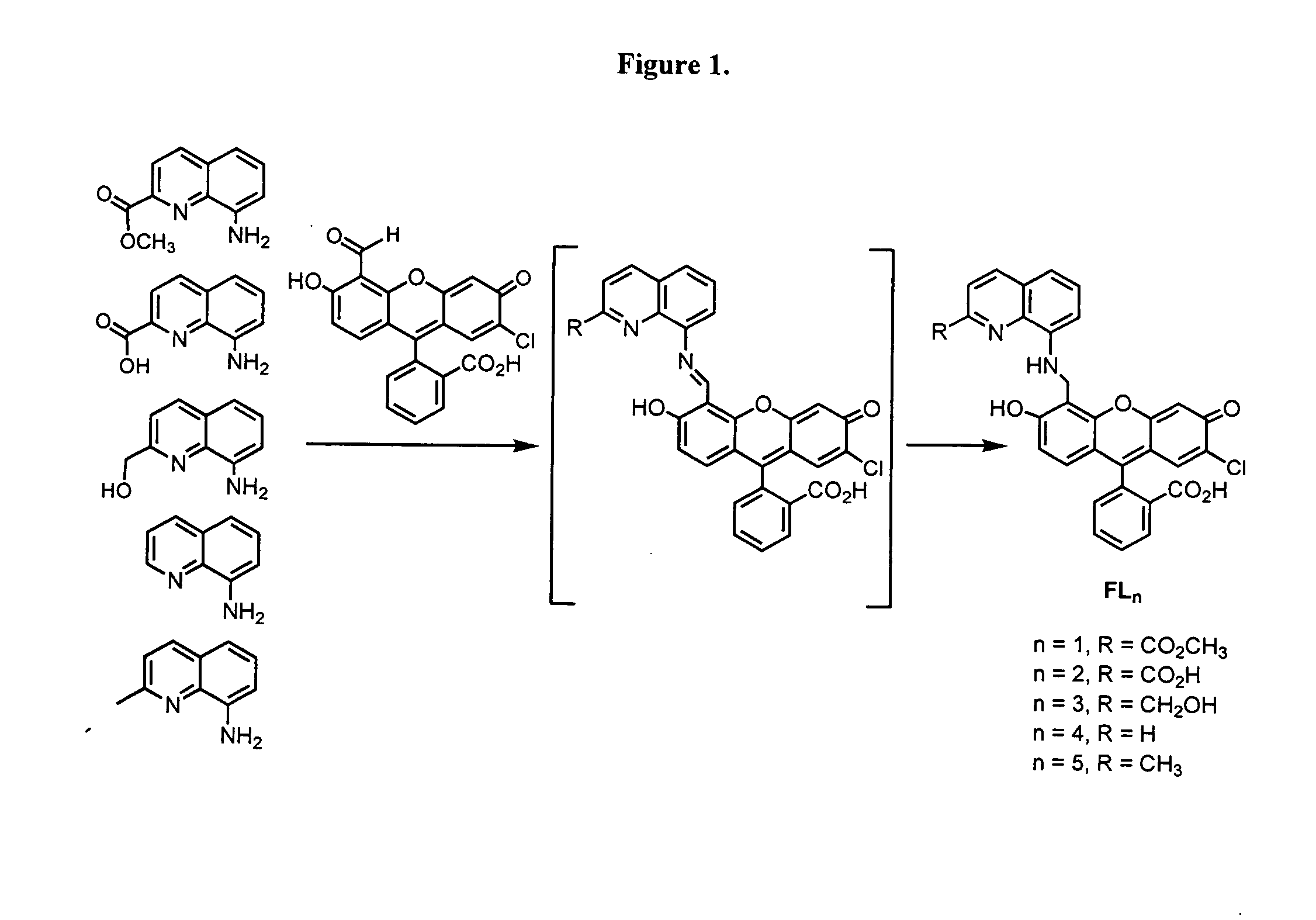Fluorescein based sensors for tracking nitric oxide in live cells
a technology of fluorescein and live cells, applied in the direction of instruments, organic chemistry, material analysis through optical means, etc., can solve the problems of complicated deciphering of these roles and implications, limited use of fluorescence technology for a particular application, and complicating the delineation of these various processes. , to achieve the effect of increasing brightness
- Summary
- Abstract
- Description
- Claims
- Application Information
AI Technical Summary
Benefits of technology
Problems solved by technology
Method used
Image
Examples
example 1
Synthesis of Copper-Fluorescein Sensors
[0265]FIG. 1 depicts the synthetic strategies for the five fluorescein ligands FLn (n=1-5).
[0266]FIG. 2 depicts the structures of the five fluorescein ligands.
[0267]Fluorescence studies of the five sensors are depicted in FIG. 3.
example 2
Detailed Synthetic Method for Copper-Fluorescein Sensor Cu(FL5)
[0268]Derivatized fluorescein molecules are excellent biosensors because they excite and emit in a region of the visible spectrum that is relatively free of interference. We prepared the fluorescein-based ligand FL5 (FIG. 4) by reacting 7′-chloro-4′-fluorescein-carboxaldehyde with 8-aminoquinaldine. We generated the Cu(II) fluorescein-based NO probe Cu(FL5) (FIG. 4) in situ reacting FL5 (prepared as described below) a with CuCl2 in a 1:1 ratio in buffered aqueous solution (50 mM PIPES, pH 7.0, 100 mM KCl). The Cu(II) species exhibited a blue-shifted λmax at 499 nm (e=4.0×104 M−1cm−1), compared to that of FL5 (504 nm, ε=4.2×104 M−1cm−1). A Job's plot was constructed to evaluate the nature of the FL5:Cu(II) complex by following the UV-vis absorption spectral change at 512 nm in pH 7.0 buffered solution. A break at 0.5 indicated the formation of a 1:1 complex. The negative ion electrospray mass spectrum of this species disp...
example 3
Fluorescence and Mechanistic Studies of Cu(FL5) with NO
[0271]The fluorescence of a 1 μM FL5 solution was diminished by 18±3% upon introduction of an equimolar quantity of CuCl2 at 37° C. Addition of excess NO to a buffered aqueous Cu(FL5) solution led to an immediate 11.2±1.5-fold increase in fluorescence (FIG. 5). Fluorescence was also enhanced when Cu(FL5) was allowed to react with the NO-releasing chemical agent S-nitroso-N-acetyl-D,L-penicillamine (SNAP) at pH 7.0 (50 mM PIPES, 100 mM KCl) over a 30 min time interval. This result demonstrates rapid NO detection with significant turn-on emission at a physiologically relevant pH. The lower detection limit for NO is 5 nM. The fluorescence response of the Cu(FL5) probe detects NO specifically over other reactive species present in biological systems, including O2−, ClO−, H2O2, HNO, NO2−, NO3−, and ONOO− (FIG. 6).
[0272]A commercially available NO probe, DAF-2 (o-diaminofluorescein), was used for comparison with Cu(FL5). The fluoresce...
PUM
| Property | Measurement | Unit |
|---|---|---|
| emission wavelengths | aaaaa | aaaaa |
| excitation wavelengths | aaaaa | aaaaa |
| pH | aaaaa | aaaaa |
Abstract
Description
Claims
Application Information
 Login to View More
Login to View More - R&D
- Intellectual Property
- Life Sciences
- Materials
- Tech Scout
- Unparalleled Data Quality
- Higher Quality Content
- 60% Fewer Hallucinations
Browse by: Latest US Patents, China's latest patents, Technical Efficacy Thesaurus, Application Domain, Technology Topic, Popular Technical Reports.
© 2025 PatSnap. All rights reserved.Legal|Privacy policy|Modern Slavery Act Transparency Statement|Sitemap|About US| Contact US: help@patsnap.com



